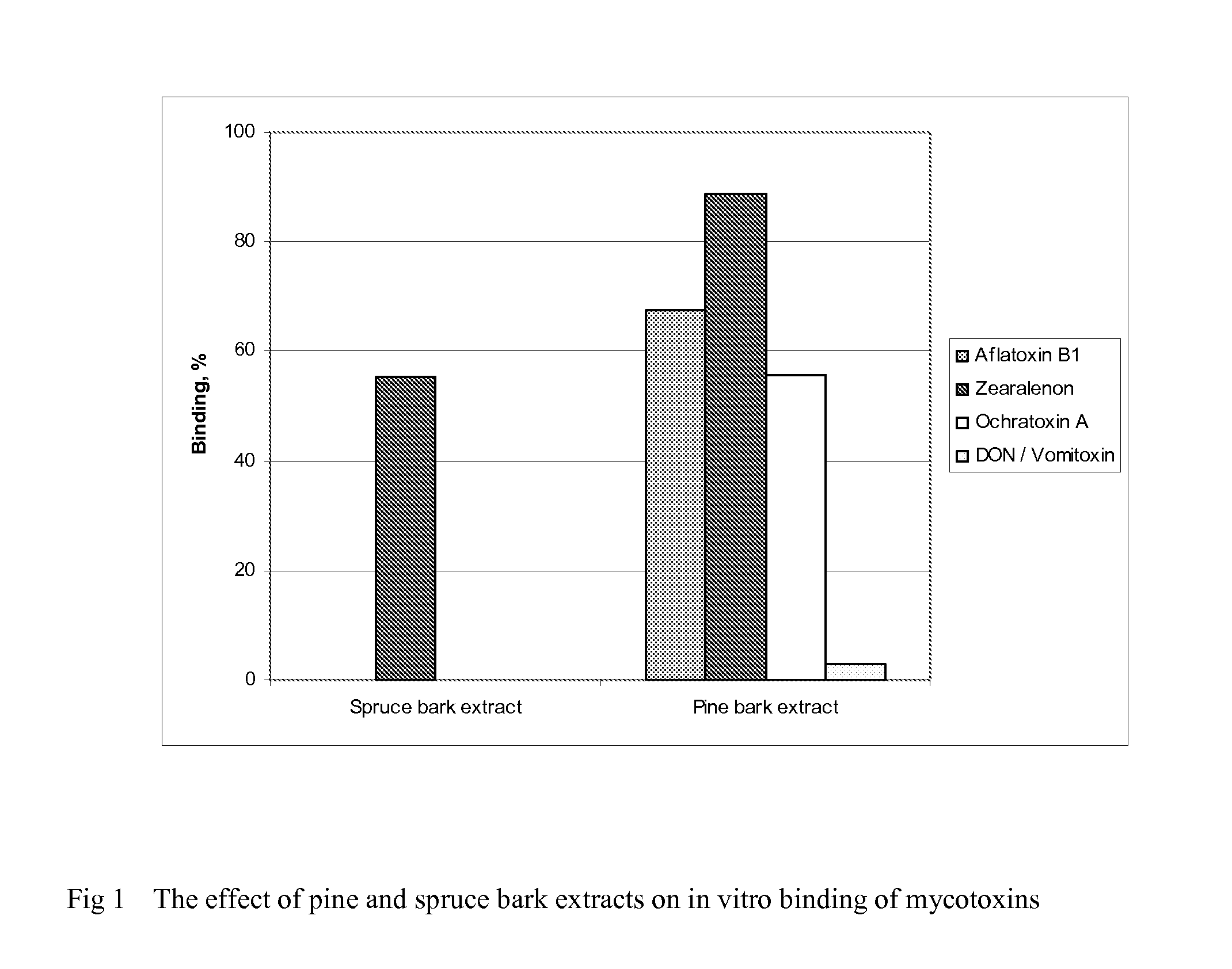Method for modulating animal digestive tract microbiota and feed composition comprising bark extract
- Summary
- Abstract
- Description
- Claims
- Application Information
AI Technical Summary
Benefits of technology
Problems solved by technology
Method used
Image
Examples
example 1
Production of Pine Bark Extract
[0055]Bark of pine (Pinus sylvestris) were extracted by a mixture of ethanol and water. The compositions of the pine bark extracts (i.e. the amounts of the main components) are presented in Table 1.
TABLE 1Compositions of pine bark extracts (w-%).Pine bark extractSugars10-40%Lipophilic extractives 1-15%Polyphenols20-50%LigninMetals
[0056]The ethanol extracts were evaporated to produce dry extract.
[0057]In Table 1a it is shown a one preferred pine extract composition of the invention. The polyphenols, i.e. the polyphenolic compounds typically comprises one or more of catechins, epicathecins and / or catechin dimmers and one or more of cyanidins and / or proantocyanidins (i.e. tannins) The lipophilic extracts of the pine extract of the invention typically comprises one or more of resin acids and sterol and / or sterol esters. In a preferred pine extract of the invention the amount of tannins is between 10 and 30 w-%, preferably below 19 w-%, more preferably bel...
example 2
Production of Spruce Bark Extract
[0058]Bark of spruce (Picea Abies) was extracted by 95% ethanol. The compositions of the spruce bark extract (i.e. the amounts of the main components) are presented in Table 2.
TABLE 2Compositions of spruce bark extract (w-%).Spruce bark extractSugars10-40%Lipophilic extractives 5-20%Stilbenes 3-20%LigninUnidentified polyphenolic compounds10-40%Metals
[0059]In Table 2a it is shown a one preferred spruce extract composition of the invention. The polyphenols (polyphenolic compounds) of the spruce extract of the invention typically comprises 10 to 50 w-%, preferably 10 to 40 w-% of tannins. The lipophilic extracts of the pine extract of the invention typically comprises 2 to 10 w-% of resin acids.
TABLE 2aCompositions of a preferred spruce bark extract (w-%).Spruce bark extractStilbenes10-20%Resin acids 2-10%Sugars 0-15%Tannins10-50%
example 3
Improved Feed Conversion Rate with Broilers and Piglets and Pathogen Elimination from Digestive Tract
[0060]The effect of pine bark extract on animal growth, feed consumption and feed conversion rate was tested in a broiler trial and a piglet trial. The extracts were obtained by the procedure described in Example 1.
[0061]In broiler trial newly hatched male chicks were randomly divided in groups of six. The number of tested product candidates were two, each tested at two doses. Each test feed was fed to five floor pens (6 birds / pen). One group of birds served as a control with no products amendment. Hence, the total number of birds was 150 (5 treatments×5 pens×6 birds / pen). The formula of the basic diet was conventional broiler feed that was supplemented as listed below.[0062]1. Control diet with no amendments[0063]2. Pine bark extract, 0.6 kg / tn[0064]3. Pine bark extract, 2.4 kg / tn
[0065]The newly hatched broiler chickens were fed for 21 days prior to killing. Feed consumption per pen...
PUM
 Login to View More
Login to View More Abstract
Description
Claims
Application Information
 Login to View More
Login to View More - R&D
- Intellectual Property
- Life Sciences
- Materials
- Tech Scout
- Unparalleled Data Quality
- Higher Quality Content
- 60% Fewer Hallucinations
Browse by: Latest US Patents, China's latest patents, Technical Efficacy Thesaurus, Application Domain, Technology Topic, Popular Technical Reports.
© 2025 PatSnap. All rights reserved.Legal|Privacy policy|Modern Slavery Act Transparency Statement|Sitemap|About US| Contact US: help@patsnap.com


